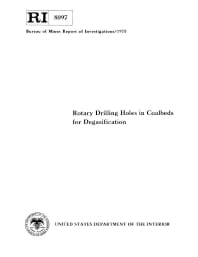Mining Publication: Rotary Drilling Holes in Coalbeds for Degasification
Original creation date: January 1975
Authors: J Cervik, HH Fields, GN Aul
NIOSHTIC2 Number: 10000710
Pittsburgh, PA: U.S. Department of the Interior, Bureau of Mines, RI 8097, 1975 Jan; :1-21
Coal is a soft and brittle material. Drilling rates in the Pittsburgh coalbed using a drag bit exceed 3 ft/min at 2,500-pound thrust. However, maintaining the bit on a horizontal trajectory or parallel to bedding planes to attain lengths of 1,000 feet is difficult. This Bureau of Mines report presents a drill string configuration that can be guided through the coalbed. The angle of the borehole is measured periodically and by proper combinations of bit thrust and rotational speed (r/min), bit trajectory can be lifted or dropped to keep the bit in the coalbed. An example of a hole drilled to 2,126 feet is presented to show levels of thrust and rotational speed used to lift or drop the bit, the seemingly unexplainable events that occur, and the strategy used during drilling. Thrust levels during drilling range from 600 to 2,500 pounds. Hydraulic motors powered by a 30-hp, 440-volt motor provide ample power for drilling horizontal holes 2,000 feet long.

NIOSHTIC2 Number: 10000710
Pittsburgh, PA: U.S. Department of the Interior, Bureau of Mines, RI 8097, 1975 Jan; :1-21
- Cableless Electronic Surveying Systems for Horizontal Holes
- Coal Mine Methane: A Review of Capture and Utilization Practices with Benefits to Mining Safety and to Greenhouse Gas Reduction
- Comparison of Rotary and In-Hole Motor Techniques for Drilling Horizontal Boreholes in Coal
- Degasification and Production of Natural Gas From an Air Shaft in the Pittsburgh Coalbed
- Hydraulic Stimulation Increases Degasification Rate of Coalbeds
- Probability of Encountering Coalbed Discontinuities During Vertical and Horizontal Borehole Drilling
- Rotary Drilling Techniques Used in the Beckley Coalbed
- Three Coal Mine Gob Degasification Studies Using Surface Boreholes and a Bleeder System
- Two-Phase Flow in Coalbeds
- Use of Vertical Boreholes for Assisting Ventilation of Longwall Gob Areas